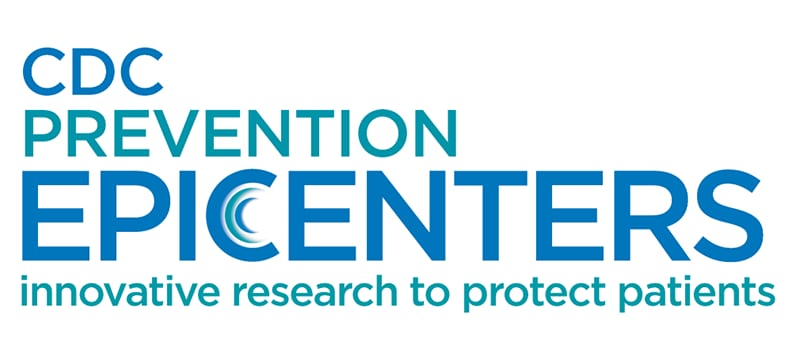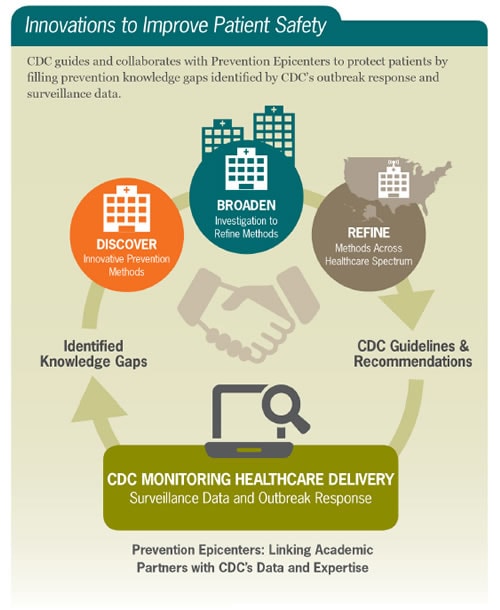About the Prevention Epicenters Program

CDC’s Prevention Epicenters Program is a unique research program working to implement innovative strategies to improve healthcare quality and patient safety. CDC’s Division of Healthcare Quality Promotion (DHQP) began the Prevention Epicenters Program in 1997 as a way to work directly with a network of academic medical centers to address important scientific questions regarding prevention of healthcare-associated infections (HAIs), antibiotic resistance, microbiome health (gut bacteria), and other healthcare-associated adverse events.
Through the Prevention Epicenters Program, academic leaders in healthcare epidemiology can work together and with CDC to conduct innovative research designed to fill gaps in public health knowledge. The emphasis on multi-center collaborative research projects has been extremely valuable to the field. The Prevention Epicenters Program has successfully translated several arms of research into clinical best practices and published hundreds of articles in peer-reviewed journals.
There are currently 11 funded Epicenters
2021–2026 Prevention Epicenters
- Duke University-University of North Carolina Prevention Epicenter
- Prevention Epicenter of Emory and Atlanta Consortium Hospitals (PEACH) Prevention Epicenter
- Harvard Pilgrim Health Care Institute Center for Excellence in HAI Surveillance and Prevention
- The Johns Hopkins Prevention Epicenter
- Infection Prevention and Antimicrobial Stewardship Minding the Gaps: The Iowa Prevention Epicenter
- University of Maryland, Baltimore Epicenter
- Rush University’s Chicago Prevention and Intervention Epicenter III (CPIE-III)
- Southeastern Pennsylvania Adult and Pediatric Prevention Epicenter Network
- University of Utah Prevention Epicenter, Intermountain Program on Antibiotic Resistance and Microbial Threats (IMPART)
- J. Craig Venter Institute and Cleveland VA Prevention and Intervention Epicenter
- Washington University (WU)/ Barnes-Jewish/Christian (BJC) Prevention Epicenter
History
Eight Prevention Epicenters were funded for three years in the initial funding cycle. To continue these efforts and support this critical research program, DHQP has extended the program through four additional funding cycles, with varying numbers of centers in each cycle. In recent years, CDC has funded eleven Epicenters.
The purpose of the Prevention Epicenters Program is to develop, implement, and evaluate the effectiveness of epidemiologically based strategies to improve healthcare quality and assure patient safety. Topics addressed include but are not limited to preventing healthcare-associated infections and stopping the spread of antimicrobial-resistant germs.

Text Alternative:
Innovations to Improve Patient Safety CDC guides and collaborates with Prevention Epicenters to protect patients by filling prevention knowledge gaps identified by CDC’s outbreak response and surveillance data.
An image of a circular process shows how Prevention Epicenters Link Academic Partners with CDC’s Data and Expertise. The image describes the cyclical process of how information gathered through CDC activities, such as gathering surveillance data and responding to outbreaks at facilities across the nation, can inform guidelines and recommendations.
- First, CDC MONITORS HEALTHCARE DELIVERY. This leads to:
- Identifying Knowledge Gaps that CDC and the Prevention Epicenters seek to fill through 3 steps:
- Discovering innovative prevention methods,
- Broadening investigation to refine methods, and
- Refining methods across healthcare spectrum.
- These steps can inform CDC Guidelines and Recommendations.
- Identifying Knowledge Gaps that CDC and the Prevention Epicenters seek to fill through 3 steps:
- This partnership all leads back to CDC MONITORING HEALTHCARE DELIVERY.